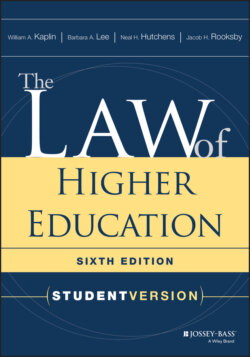Читать книгу The Law of Higher Education - William A. Kaplin - Страница 41
Notes
Оглавление1 1 Terms appearing in bold face type are included in the Glossary, which is found in Appendix D.
2 2 Much of the introductory content of this section is adapted from Kathleen Curry Santora and William Kaplin, “Preventive Law: How Colleges Can Avoid Legal Problems,” Chron. Higher Educ., April 18, 2003, B20 (copyright © 2004 by Chronicle of Higher Education, Inc.).
3 3 For an overview of Congress's express powers, and an explanation of its implied powers, see William Kaplin, American Constitutional Law: An Overview, Analysis, and Integration (Carolina Academic Press, 2004), chapter 6, section B, A through F.
4 4 Although this inquiry has arisen mainly with regard to the federal Constitution, it may also arise in applying state constitutional guarantees. See, for example, Stone by Stone v. Cornell University, 510 N.Y.S.2d 313 (N.Y. 1987) (no state action).
5 5 This recognition that education, having a history of strong roots in the private sector, does not fit within the public function category was evident well before Rendell-Baker; see, for example, Greenya v. George Washington University, 512 F.2d 556, 561 (D.C. Cir. 1975). For the most extensive work-up of this issue in the case law, see State v. Schmid, 423 A.2d 615, 622–24 (majority opinion), 633–36 (Pashman, J., concurring and dissenting), 639–40 (Schreiber, J., concurring in result) (N.J. 1980). For another substantial and more recent work-up, see Mentavlos v. Anderson, 249 F.3d 301, 314–18 (4th Cir. 2001), discussed below in this subsection.
6 6 The Washington Supreme Court's decision was reversed, on other grounds, by the U.S. Supreme Court in Gonzaga University v. Doe, 536 U.S. 273 (2002). The Supreme Court's decision is discussed in Section 7.8.1 of this book.
7 7 The court also used public function analysis (see 249 F.3d at 314–18), rejecting the plaintiff's arguments based on this approach because the Citadel was not analogous to the federal military academies, and the institution and the cadets therefore were not performing the traditional sovereign function of training men and women for service in the U.S. Armed Forces.
8 8 As Mentavlos suggests, if the harassers had been employees of a public institution rather than students, the employees would likely have been found to be engaged in state action. For a case reaching this result, see Hayut v. State University of New York, 352 F.3d 733, 743–45 (2d Cir. 2003).
9 9 The status of Roemer and also Mitchell has been addressed at great length in Fourth Circuit litigation.See Columbia Union College v. Clarke, 159 F.3d 151 (4th Cir. 1998) (Columbia Union College v. Clarke I); Columbia Union College v. Oliver, 254 F.3d 496 (4th Cir. 2001) (Columbia Union College v. Clarke II).
10 10 See, e.g., Steel v. Industrial Development Board of Metropolitan Government of Nashville, 301 F.3d 401 (6th Cir. 2002); Virginia College Building Authority v. Lynn, 538 S.E.2d 683 (Va. 2000).
11 11 For instance, the Court emphasized that the state's scholarship program “does not require students to choose between their religious beliefs and receiving a government benefit” (540 U.S. at 721–22); and yet it later acknowledged that “majoring in devotional theology is akin to a religious calling” and that Davey's “religious beliefs” were the sole motivation for pursuing such studies (540 U.S. at 721). It thus seems that, for Davey, the state did indeed put him in the position of choosing between his religious calling and his Promise Scholarship.
12 12 The discussion in this section—especially the middle portions that differentiate particular policy makers' functions from those of attorneys, identify alternative policy-making processes, set out the steps of the policy-making process and the characteristics of good policy, and review structural arrangements for facilitating policy making—draws substantially upon these very helpful materials: Stephen Dunham, “Preventive Lawyering: Drafting and Administering Policies to Avoid Litigation” (February 2001), a conference paper delivered at the 22nd Annual Law and Higher Education Conference sponsored by Stetson University College of Law; Linda Langford & Miriam McKendall, “Assessing Legal Initiatives” (February 2004), a conference paper delivered at the 25th Annual Law and Higher Education Conference sponsored by Stetson University College of Law; Kathryn Bender, “Making and Modifying Policy on Campus: The ‘When and Why’ of Policymaking” (June 2004), a conference paper delivered at the 2004 Annual Conference of the National Association of College and University Attorneys; Tracy Smith, “Making and Modifying Policy on Campus” (June 2004), a conference paper delivered at the 2004 Annual Conference of the National Association of College and University Attorneys; and “Policy Development Process with Best Practices,” a document of the Association of College and University Policy Administrators, available (along with additional resources on developing and implementing policy) on the association's website at https://acupa.org.
13 13 The focus on administrators and counsel, here and elsewhere in this section, does not mean that faculty (the educators) are, or should be, cut out of the policy-making process. This section is based on the assumptions that administrators are sometimes faculty members or educators themselves; that administrators will regularly provide for faculty participation in policy-making committees and task forces; that administrators who oversee academic functions will regularly consult with pertinent faculties of the institution, directly and/or through their deans; and that administrators will respect whatever policy-making and decision-making roles are assigned to faculty under the institution's internal governance documents.
